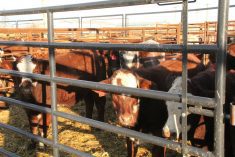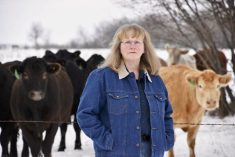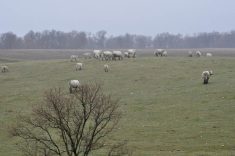Farmers and ranchers who work with livestock need to stay vigilant around those animals.
“Most ranchers and farmers who have cattle and horses like working with animals and interacting with them,” said Charlie Stoltenow, an extension service veterinarian with North Dakota State University at Fargo.
“The more they work with cattle and horses, the more comfortable they become around the animals. And with that comfort, producers sometimes take their animals for granted. This is a serious and dangerous mistake. Worker safety around cattle and horses requires respect for the animals and concentrating on the task at hand.”
Read Also

Pig transport stress costs pork sector
Popular livestock trailer designs also increase pig stress during transportation, hitting at meat quality, animal welfare and farm profit, Agriculture and Agri-Food Canada researcher says
Data collected in Colorado from 1997 to 2006 indicated that riding horses, sorting/ penning cattle and using livestockhandling equipment resulted in the highest rates of injury among cattle/livestock producers and cattle dealers.
Livestock was responsible for the highest percentage of non-fatal agricultural injury claims, the study found. Livestock were responsible for 27 per cent of cattle dealers’ injury claims and 22 per cent of claims from cattle/livestock producers.
Livestock injuries represented the highest proportion of high-cost injuries
(US$5,000 or more) and the highest proportion of high-severity claims (28 or more days of paid disability). Of those, horses were involved in 38 per cent of injuries for cattle/livestock producers and 27 per cent of injuries for cattle dealers.
A 2002 Kentucky Department of Health Services study indicated that 50 per cent of cattle-related injuries involved cattle confined for medical procedures or for loading and transport.
Livestock-related injuries do not happen only to adults, Stoltenow said. A study published in 2003 from the University of Kentucky indicated that the injury rate for farm children age 18 or older was 2.8 per 100 children. Boys ages 16 to 18 had an injury rate of 9.2 per 100 children. Cattle and horses were one of the primary external causes of non-fatal farm work injuries in children, the study showed.
The most common types of livestockrelated injuries involve animals:
Stepping on the handler
Slipping and falling on the handler
Pinning or squeezing the handler against a barrier
Kicking the handler
Veterinarians are not immune to livestock-related injuries either, Stoltenow said. A 1998 study based on survey results from 995 veterinarians in Minnesota and Wisconsin indicated 65 per cent had sustained a major animal-related injury during their career and 17 per cent of these required hospitalization within the past year, with 25 per cent of these requiring surgery. Fifty-two per cent of the veterinarians surveyed reported hand injuries, while 28 per cent reported trauma to the arms and 21 per cent reported trauma to the head.
Fatalities related to livestock also are all too common, according to Stoltenow. Information from Oregon State University indicates that bulls are responsible for more than half of all fatalities related to livestock.
Three fatalities related to bulls were described in the February 2009 issue of Bovine Veterinarian. A common thread among the cases was lack of respect for the power and speed of the animal, lack of safety precautions and lack of concentration concerning the task at hand. Bulls account for about three per cent of the cattle population but about 15 per cent of cattle-related injuries.
Recommendations for handling livestock include:
Teaching proper animal-handling techniques based upon animal behaviour
Attending a course in low-stress handling of livestock
Using well-designed confinement facilities and equipment
Reducing noise and stress when working with animals
Making sure only family members of an appropriate age and physical ability undertake livestock-handling tasks
“Working with livestock should be an enjoyable experience,” Stoltenow said.
“Think ahead and be prepared. Invest a little money in quality livestockhandling equipment. Safety is not an area where a person should try to cut corners. It is too late after a livestockrelated injury or death to start thinking about safety.”


















